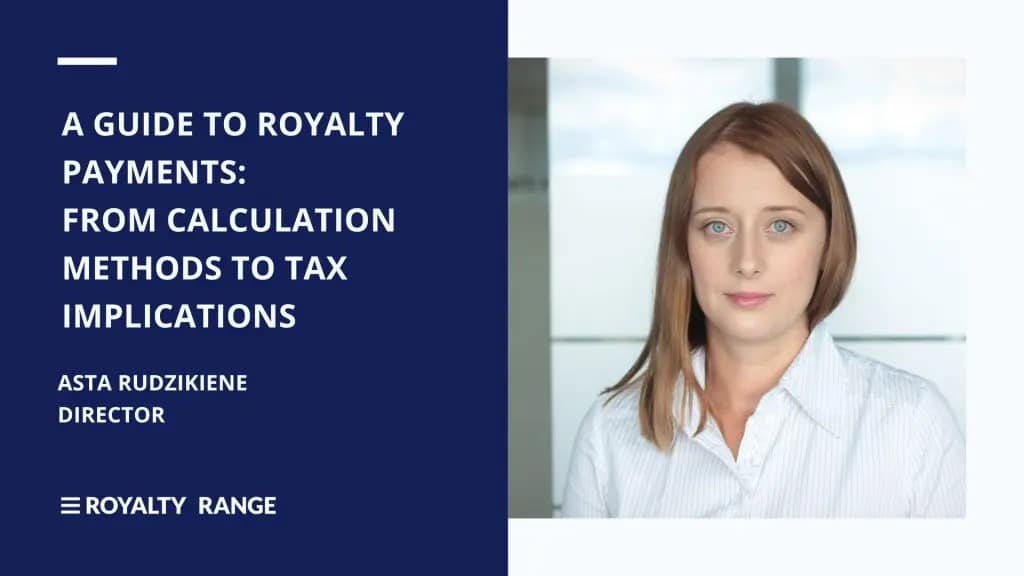A guide to royalty payments: from calculation methods to tax implications

Asta Rudzikiene |
July 15, 2023

For any company looking to enter into a license agreement, understanding the fundamentals of royalty payments is essential: how they work, how they’re calculated, and how they’re treated from a tax perspective.
Royalty payments allow intellectual property (IP) owners to monetise their creations and receive compensation for their use by others. They also enable licensees to invest in new assets in a cost-effective way.
Below we take a closer look at how royalty payments work, along with financial regulations, tax considerations, and how these vary in some key global territories.
For help determining royalty payments, check out our royalty rates database, relied on by multinational enterprises, global consulting companies, international law firms and tax authorities around the globe, and our royalty rate benchmarking tool here.
Royalty payments: the fundamentals
What are royalty payments?
Royalty payments are legally binding payments made by a third party to an individual or company for the ongoing use of their assets, which are usually in the form of ‘intangibles’, i.e. “something which is not a physical asset or a financial asset, which is capable of being owned or controlled for use in commercial activities, and whose use or transfer would be compensated had it occurred in a transaction between independent parties in comparable circumstances”.
What different types of royalty payments are there?
The payment of royalties provides a vital function in creating a fair and equitable way for innovators or owners of IP to receive due compensation for their work. Royalties also play a pivotal role for businesses, giving them legal rights to IP without impinging on an owner’s exclusive rights.
Royalty payments can apply under the terms of licensing agreements for:
- Art – including books, music, performing and visual arts
- Photography, video, and digital content
- Patents, trademarks, copyright, and know-how
- Business franchises
- Oil and gas mining royalties
What are common royalty payment structures?
Royalties are typically agreed as part of licensing agreements between a licensor and the licensee. Depending on the type of asset or other factors, various payment structures may be used.
Most structures involve determining payments based on a percentage of the revenue or profits earned from using the IP. For patents, in particular, royalty payment structures are often based on a fixed percentage of sales or a flat fee per unit sold. Franchises often involve a significant initial royalty fee, in addition to percentage royalties, to account for the brand equity already established in the franchise. For newer IPs, the initial royalty percentage may start small and increase as sales take off.
How are royalty payments calculated?
Of course, it’s essential that all parties agree on fair royalty rates. Rates may be negotiated based on a number of factors, such as exclusivity, market demand, brand recognition, geographical region, and competitor analysis. It is also important for parties to consider industry benchmarks, market research, and the potential value the IP will bring to the licensee.
To determine accurate royalty rates, parties typically rely on access to high-quality comparative data. Commercial databases are a practical and cost-effective way of identifying external comparables. They can provide the most reliable source of information, giving parties confidence that their royalty agreement features optimum royalty rates for all concerned.
Learn more about how to calculate royalty payments with our benchmarking tool here.
Royalty payments and tax considerations
Below you can see how royalty payments are accounted for in different countries from a tax perspective.
UK
Royalties are part of business income, counting towards annual tax. Individuals receiving royalties must declare earnings on their self-assessment but can make use of the trading allowance of £1000 to reduce the tax burden.
In 2017, a government consultation regarding the impact of the digital economy resulted in tweaks to royalty taxation. Under the current system, companies making royalty payments in specific areas will need to deduct withholding tax at 20% from those royalties.
Europe
Under the EU Interest and Royalties Directive (IRD), EU companies are allowed to make certain interest and royalty payments to associated companies within the EU without deducting tax. Since Brexit, this no longer applies to the UK.
USA
Businesses can generally take a tax deduction for royalty payments as expenses. The IRS treats royalty income as ordinary income reportable either on Schedule E for Supplemental Income & Loss or Schedule C for self-employed people. Paying royalties or licensing fees might fall under business expenses, and payments over $10 a year must be reported on a 1099-MISC form to show total payments.
International
International transactions involving royalty payments may require compliance with transfer pricing regulations, which aim to ensure that royalty payments are conducted at arm’s length. These regulations prevent tax evasion and ensure that intercompany transactions are conducted at fair market value. You can read more about arm’s length transactions in our blog post here.
Royalty payments: Looking to the future
As the world becomes increasingly digitised and intangibles such as digital content and software transform the landscapes of technology and creative industries, royalties will continue to play a crucial role for creators and businesses alike. New forms of IP are emerging in the global economy, making the calculation, tracking and enforcement of royalties ever more challenging.
“Although advancements are continually occurring, it is reliable, accessible comparative data that remains the key to royalty agreements that provide mutually beneficial payment terms, as well as encourage collaboration and innovation,” says Kris Rudzika, Managing Partner at RoyaltyRange.
When it comes to finding the highest quality data for setting fair and accurate royalty rates, the RoyaltyRange database is the go-to tool for multinational enterprises, global consulting companies, international law firms and tax authorities in more than 70 countries around the world.
Ready to get started? Use the search box on the right to begin your royalty rates search.
Or, if you’d like to find out more, read about how our royalty rates search service works.
The information provided below is for general informational purposes only and should not be construed as legal or tax advice. It is not a substitute for consulting with a qualified legal or tax professional.
Request One Search
We will perform the search and deliver the initial results within hours, at no cost.




